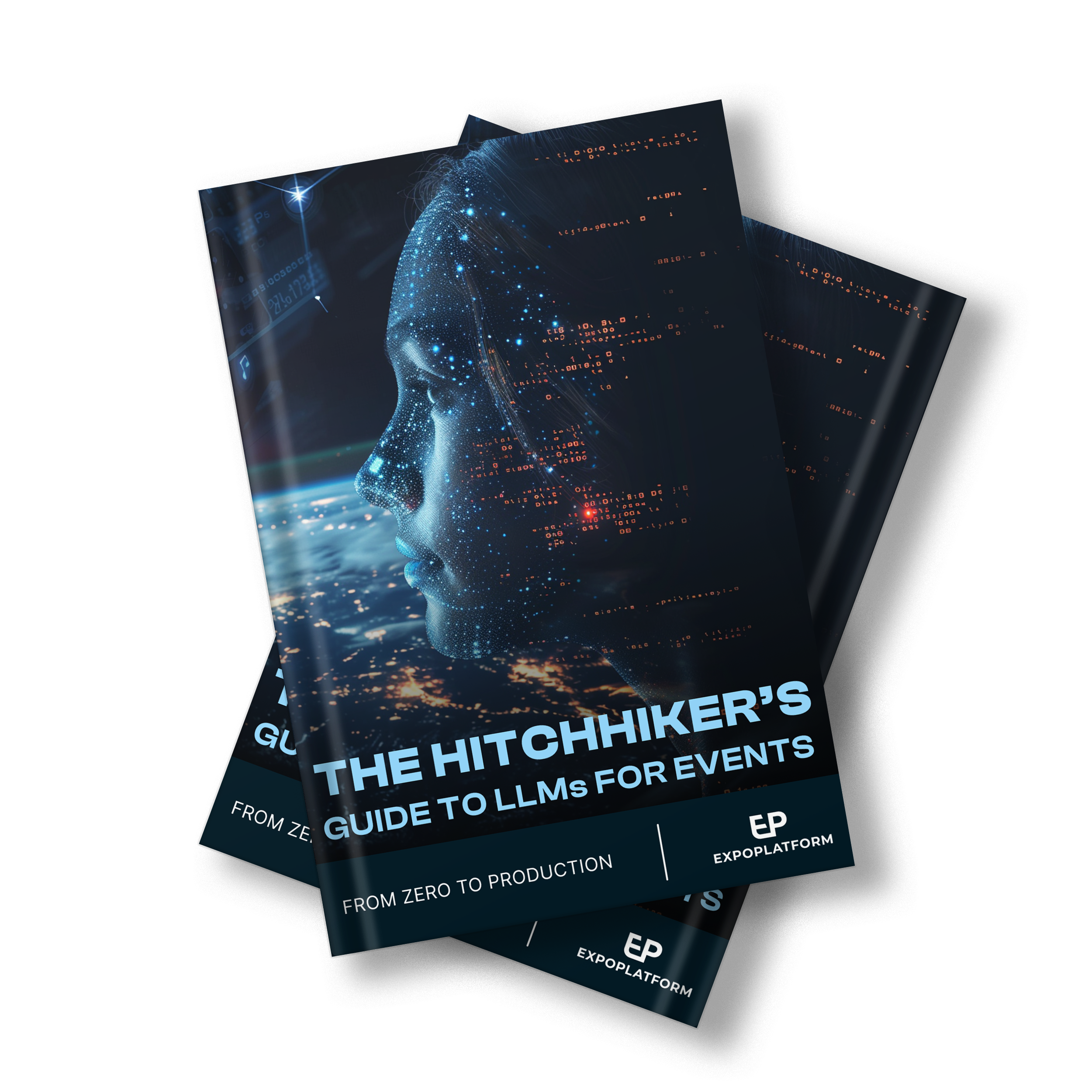
How to select the best tradeshow software: a complete guide
Choosing the right event tech software can significantly improve the value proposition of your tradeshow – but how do you do it?
Factors that influence your selection -include user experience, scalability, integration capabilities, analytics and reporting tools and more.
This buyer’s guide will answer all your questions to help you purchase the best tradeshow software. Here’s what we will cover:
- What is tradeshow software?
- Advantages of using tradeshow software
- Selecting the best tradeshow software – the basics
- Audience considerations
- Event management features
- User experience and usability
- Cost and budgeting
- Data security
What is tradeshow software? 🤔
Tradeshow software is a set of online tools and solutions designed to manage and automate various aspects of tradeshow planning, management and execution.
These features can range from attendee registration, booth management and AI-powered networking to lead capture, data analytics, floor planning and monetisation.
By leveraging the power of technology, tradeshow software empowers organisers to focus on their event goals and create memorable experiences for their target audience.
Learn more how ExpoPlatform’s tradeshow solutions work
Advantages of using tradeshow software ✔️
Tradeshow software offers a myriad of advantages for organisers. For example:
1. Streamlined processes: Trade show software automates various tasks such as exhibitor registration, attendee management, floor planning, and marketing. This streamlines processes, reduces manual effort, and saves time, allowing organisers to focus on other critical aspects of event planning.
2. Enhanced attendee experience: Organisers can provide attendees with user-friendly interfaces, personalised schedules, interactive maps, and networking features. It facilitates seamless communication, simplifies registration and ticketing, and improves overall attendee engagement and satisfaction.
3. Improved exhibitor management: Enable efficient exhibitor management by automating processes such as booth assignments, payments and document submission. It simplifies communication between organisers and exhibitors, enhances exhibitor profiles, and ensures a smooth experience throughout the event.
4. Real-time data and analytics: Get valuable insights into attendee behaviour, preferences and event performance. Organisers can track metrics such as attendance rates, ticket sales and exhibitor ROI in real-time. This helps optimise future events, make data-driven decisions and measure the success of the show.
5. Effective marketing and promotion: Tradeshow software offers comprehensive marketing and promotion tools. It allows organisers to create visually appealing event websites, integrate social media platforms and conduct targeted email marketing campaigns. This ensures wider event visibility, boosts attendance and generates higher exhibitor and sponsor interest.
6. Flexibility and adaptability: These tools can be customised and adapted to different event requirements e.g. accommodating different booth layouts, floor plans and exhibitor needs. The software also allows for last-minute changes and updates, ensuring organisers can efficiently adapt to unforeseen circumstances.
7. Improved communication and collaboration: Facilitate seamless communication between organisers, exhibitors and attendees. It provides messaging and networking features that enable attendees to connect with exhibitors, speakers, and each other. This fosters collaboration, networking opportunities and better engagement throughout the event and beyond.
8. Cost-efficiency: Tradeshow software does require an initial investment, but it usually leads to long-term cost savings. By automating processes and reducing manual effort, organisers can optimise resource utilisation and minimise administrative expenses. The software can also increase exhibitor ROI and generate higher revenue through enhanced attendee experiences and targeted marketing.
Selecting the best tradeshow software – the basics 🛠️
A tradeshow is a complex affair with many moving parts – and you need to make sure your software delivers on each aspect.
Here is a roundup of the basics:
- First, the software should be suitable for managing different types of events. Whether you are organising in-person, virtual or hybrid events, it should be able to handle the specific requirements of each event type. This could include tools for hosted buyer programmes, attendee networking, session scheduling and live streaming capabilities.
- Secondly, it is crucial to have the features needed to manage the entire tradeshow process. These can be factors such as registration management, exhibitor management, attendee engagement tools, analytics and reporting capabilities and integration options with other systems you may be using.
- User experience and usability are also crucial factors to consider. The software should have a well-designed interface that is intuitive and easy to navigate. It should provide a seamless and enjoyable experience for both event planners and attendees. Additionally, supporting documentation, tutorials, and customer support should be readily available to help users effectively utilise the software’s features.
- Cost considerations play a significant role in selecting the best tradeshow software. Evaluate the pricing structure, whether it is based on a one-time fee or a monthly subscription. Consider any additional costs, such as fees for additional users or technical support. It is also important to weigh the value the software provides against its cost and budget accordingly.
Let’s understand these factors in a wider context 👇
Read more ➡️ Event data is ‘key to future’ of tradeshows
Audience considerations
Your target audience is crucial to selecting the right tradeshow software.
Different events attract different types of attendees and it’s important to choose software that addresses their needs and preferences.
Understanding your audience and their expectations will help you provide the best experience for both exhibitors and attendees.
Additionally, consider any language or cultural considerations that may be relevant for your target audience, as this may impact the software’s localisation and customisation options.
By taking audience considerations into account, you can ensure the solution you choose will effectively engage and satisfy your attendees.
Who is your target audience?
To choose your target audience, start by defining the objective of your tradeshow and the desired level of creativity and technical competence. Consider the type of industries or niches that align with your event’s theme or purpose. For example, if you’re organising a fashion event, your audience will retailers, fashion industry professionals, suppliers and stylists.
➡️ Conduct audience research to gain insights into their preferences and behaviours. Utilise social media platforms and hashtags relevant to your industry or event to discover communities of interest. Analyse your competitors’ events and evaluate their target audience to understand who might be interested in your event as well.
➡️ Selecting the right target audience will help you create a successful and engaging tradeshow experience. It allows you to customise your event content, promotions and activities to attract and resonate with the attendees who are most likely to benefit from and contribute to your event’s success.
➡️ Also consider your event sponsors who will be looking for value and ROI before deciding to support your show. This could be through increased brand visibility, lead generation or networking opportunities with industry professionals.
How to engage with your audience more effectively?
For enhanced engagement, it is crucial to employ tools that speak to their requirements.
Incorporate interactive elements such as Q&A sessions and live polls – these boost participation and give insights into the audience’s thought process.
By allowing them to actively contribute to the discussion, you create a more engaging and inclusive environment.
It’s also important to properly understand the buyer persona to tailor your content and discussions to resonate with them.
For instance, tools like an exhibitor manual help seamlessly onboard your exhibitors to the show while a smart event app extends the digital experience.
Also read: 12 ways to boost event engagement
Event management features
The tradeshow software you select should have the necessary features that solve various aspects of your events.
You need to first define the type of event you are creating – will it just have speaker sessions and booths or also feature workshops, seminars, hosted buyer meetings and networking meetups?
Depending on the industry niche e.g. healthcare, fashion, fintech, supply chain, different features might be needed for the unique requirements of each show.
Begin by exploring the different types of tradeshow software and compile a list of software vendors and solutions that offer these features.
To make an informed decision, read reviews and testimonials from other event professionals to gauge the reputation and reliability of the software options.
Some widely-used features in popular tradeshow software are:
👉 Registration management: Online registration capabilities, customisable registration forms as well as tools for badge printing and attendee tracking.
👉 Hosted buyer programme: Connect pre-qualified buyers to exhibitors with a personalised concierge programme, saving time and increasing exhibitor ROI.
👉 Exhibitor manual: Help exhibitors get familiar with the event and make the most of their participation. It includes key show information, guidelines and resources to ensure a smooth exhibition experience.
👉 Lead capture and retrieval: Lead capture features that allow badge scans, capture contact information and score leads. Integration with customer relationship management (CRM) systems is also crucial for seamless lead management, qualification and tracking.
👉 Floor plan mapping and booth management: Interactive floor plan layouts provide visibility on the venue space and help attendees navigate from one location to another in a jiffy.
👉 Networking and matchmaking features: AI-powered matchmaking solutions increase attendee networking and appointment scheduling. In-built meetings and messaging tools enable attendees to converse and connect, ensuring higher engagement.
👉 Mobile event app: Allow your audience to connect and network, generate leads, get real-time updates and access and share content on the go – right from their fingertips.
Does the Solution Offer Additional Solutions or Benefits for Your Events?
When selecting a tradeshow software, it’s important to consider whether the solution offers additional features that can enhance your events.
Look for tools or functionalities that can streamline event management and increase attendee engagement.
One important aspect is the software’s ability to create event sponsorship packages – you should be able to create sponsorship tiers and packages that offer varying levels of exposure and benefits to sponsors. This can help attract potential sponsors and provide them with valuable opportunities to promote their brand.
Another key consideration is the software’s capability to prove event ROI to sponsors. Look for analytics and reporting features that allow you to measure various metrics like attendee engagement, lead generation, and revenue generated from sponsorships. Being able to provide data-driven insights to sponsors showcases the value they received from participating in your event and makes it easier to secure future sponsorships.
Also, check whether the tradeshow solution has any sustainability aspect attached to it. This helps bolsters the green credentials of your show without any added cost.
➡️ Learn about ExpoPlatform’s Meetings Make Trees initiative – a tree planted for every app meeting booked
User experience and usability
User experience (UX) and usability are vital factors to consider when selecting tradeshow software.
The software should have a clean and organised layout, making it easy to access and utilise its various features and tools.
Intuitive registration processes and customisable options contribute to a positive user experience, ensuring attendees can easily sign up for events or sessions.
Usability also extends to the organiser’s perspective, as the software should streamline administrative tasks and eliminate manual processes, saving time and effort for the planning team.
Ultimately, prioritising user experience and usability ensures that your tradeshow software enhances both attendee satisfaction and event management efficiency.
Does it include help documentation, tutorials and training for users?
Properly using tradeshow software needs user-friendly help documentation, tutorials and training sessions.
These resources can bring your team as well as your audience up to speed – helping save time and minimising frustration when they are operating the tool.
Comprehensive help documentation helps users learn about the various functionalities of the software and understand how to leverage them to their advantage.
Tutorials provide step-by-step guidance on how to perform specific tasks and how various features of the software work.
Cost and budgeting
When budgeting for tradeshow software, it’s important to consider various expenses.
The venue cost is a significant factor, along with expenses for food and drink, entertainment, decor, staff, marketing, software, audio/visual equipment, and miscellaneous costs.
Incorporating event management software into the budgeting process can offer several benefits.
First, it can help streamline administrative tasks and reduce manual labour costs, as the software automates several processes. This allows event planners to allocate their time and resources more efficiently.
Event management software also provides tools for tracking and managing expenses, which can improve financial transparency and control. It allows for better budget tracking, helping event planners stay on top of their spending and make necessary adjustments if needed.
Data Security
Data security is crucial for tradeshow software due to the sensitive nature of the information it handles. Here’s what you should look at:
1. Protection of attendee and exhibitor information: Trade show software typically stores personal information such as names, contact details, and financial data of attendees and exhibitors. Ensuring data security safeguards this sensitive information from unauthorised access, identity theft, or misuse.
2. Compliance with privacy regulations: Many countries have strict regulations regarding the collection, storage, and use of personal data. By implementing robust data security measures, trade show software ensures compliance with these regulations, such as the General Data Protection Regulation (GDPR) in the European Union.
3. Prevention of data breaches: Trade show software often stores a significant amount of data, including financial transactions, attendee preferences and exhibitor contracts. Without adequate security measures, this data becomes vulnerable to cyberattacks, hacking attempts, and data breaches. Protecting against such incidents is paramount to avoid reputational damage and legal consequences.
4. Safeguarding intellectual property: Trade show software may contain copyrighted materials, proprietary information or trade secrets related to event planning and management. Maintaining data security protects against unauthorised access or theft of this valuable intellectual property, ensuring the competitiveness and integrity of the event.
5. Trust and confidence of stakeholders: Organisers, exhibitors and attendees entrust their personal and financial data to tradeshow software providers. Demonstrating a commitment to data security builds trust and confidence among stakeholders, encouraging their continued participation and collaboration in future events.
6. Business continuity and disaster recovery: Robust data security measures include regular backups, data encryption and disaster recovery plans. This ensures the tradeshow software can quickly recover from any unforeseen events, such as system failures, natural disasters or cyberattacks – minimising downtime and maintaining business continuity.
7. Protection of financial transactions: Tradeshow solutions often handle financial transactions, including exhibitor payments, ticket sales and sponsorship agreements. Implementing strong data security measures helps prevent fraudulent activities, unauthorised access to financial data and the manipulation of financial transactions.
Download the Event Data Safety checklist to understand what questions you should ask before selecting a tradeshow software.
We hope you enjoyed reading this article and found it useful. At ExpoPlatform, we want to help you build better events and communities. Please get in touch and ask for a demo here. Thank you 😀
There's more you might like

10 tips to select event tech for in-person shows in 2024
Event management platforms have become essential to the success of MICE (meetings, incentives, conferences, exhibitions) shows. It’s hard to envision a conference or exhibition without technology enhancing the audience experience. Live shows are now supercharged by digital tools – online registration, badge scans, lead gen insights and data collection all happen seamlessly. Choosing the right ...

What Europe’s AI Act could mean for eventprofs
The European Union is on the brink of introducing a world-first legal framework for AI, with potential consequences for event organizers. New legislation – the Artificial Intelligence Act – has been endorsed by MEPs with 523 votes in favour, 46 against and 49 abstentions. It is aimed at mitigating risks associated with AI while fostering ...

Events industry has ‘long way to go’ on personalisation
The events industry still has “a long way to go” to improve in-person experiences through AI-powered tools, according to an expert. Matthias Tesi Baur, founder of the ETT Club, was speaking on a webinar panel dedicated to latest findings from the Event Tech Forecast 2024. It found that personalisation of experiences was the biggest opportunity for ...


